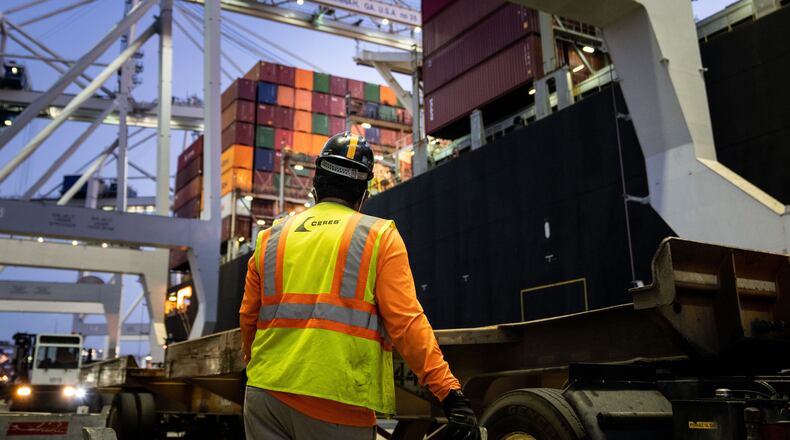SAVANNAH — The Georgia Ports Authority docks in Savannah and Brunswick are among the busiest in the United States, with crane operators and longshoremen renowned for their efficient work.
On Tuesday, that loading and unloading of ships is likely to cease at Georgia marine terminals and 13 others along the East Coast and Gulf Coast as union dockworkers, members of the International Longshoremen’s Association), are threatening to go on strike. The work stoppage would be the first since 1977 and is stems from the expiration of a six-year labor agreement between the ILA and the shipping vessel operators that transport cargo around the world.
One master contract covers all the marine terminals, which stretch from the Port of Houston to the Port of Boston, and the current dispute is largely because of disagreements over wage increases and the use of automation in moving cargo.
For the Georgia Ports Authority, though, the labor agreement carries significance beyond that of most of their fellow terminal operators. With the state authority renovating one terminal and building another, a new ILA contract could reshape the division of labor on some of Savannah’s docks and threaten its unique business structure.
Credit: Stephen B. Morton
Credit: Stephen B. Morton
Unlike the majority of other U.S. cargo ports, the GPA does not lease out its facilities to shipping companies to operate in conjunction with union dockworkers. Instead, the state authority runs the terminals in Savannah and Brunswick, negotiating vessel calls with the shippers and employing crane operators and other laborers who work alongside the ILA union members in loading and unloading the ships.
That operating model could unravel, depending on the final language in a new master contract with the ILA.
That’s after a separate legal victory by the ILA already brought the Georgia Ports Authority’s hybrid labor model into question. In a settlement involving a new cargo terminal at a state-operated port in South Carolina, the master contract calls for the ILA to have full operational control at any newly opened terminal.
The potential for changes is concerning to the authority’s chief executive, Griff Lynch, who credits the current operating structure for Savannah’s success. Cargo volumes have doubled over the past decade, and the port is now the third-busiest in the country, behind only Los Angeles and New York.
“GPA has been among the fastest-growing ports, which has benefited not just the GPA but the ILA and the state’s overall economy as well,” Lynch said. “All of us have grown and benefited appropriately, and we’ve enjoyed that growth because we are a hybrid port and because of the service we collectively provide to our customers.”
Credit: GPA Photo/Stephen B. Morton
Credit: GPA Photo/Stephen B. Morton
A terminal’s rebirth
The dispute over labor at Charleston’s Leatherman Terminal, built from part of a U.S. Navy shipyard along the Cooper River, was watched closely by many who work at the Savannah port.
The ILA filed a lawsuit soon after Leatherman opened in 2021, claiming the master contract dictated that nonunion workers could not operate cranes and heavy lift equipment at new terminals. The South Carolina Ports Authority challenged the lawsuit with the National Labor Relations Board. The federal regulators sided with the ILA, prompting the ports authority to appeal to the U.S. Supreme Court.
The nation’s highest court declined to take up the case, and the two sides reached an agreement in June, with the port ceding on-dock control to the ILA. The terminal reopened to container cargo ships last week and worked one vessel, although another Charleston terminal that still uses ports authority crane operators continues to handle ships.
The Leatherman resolution increased talk among Savannah-area ILA members about the future of operations at Ocean Terminal as well as at the planned Hutchinson Island Terminal, a project announced last year that is expected to be completed by 2030.
Ocean Terminal is in the midst of a full makeover. The terminal flanks the Talmadge Bridge just west of Savannah’s famed River Street. It has been in continuous operation since 1979 as a multipurpose cargo port, handling a mix of wheeled vehicles and bulk cargo known as breakbulk, as well as a limited number of containers.
Georgia Ports began converting it to strictly container use last year. The authority pushed its breakbulk and wheeled-vehicle business to Brunswick and began a major renovation of the 200-acre site. Even with all the construction, the ports authority has continued to work container ships at Ocean Terminal — two are scheduled this coming week, barring a strike.
The ship calls have prompted monthslong speculation among union members that the ports authority is continuing to use Ocean Terminal to preemptively combat any future claims that the retrofit facility should be considered a new terminal and thereby fully controlled by the ILA.
Local ILA leaders did not respond to interview requests about the situation. The GPA’s Lynch said the ports authority does not see Ocean Terminal, which first opened in 1948, as a new facility.
The costs of an all-ILA workforce
Directly across the Savannah River from Ocean Terminal sits the site of what will unquestionably be a new cargo container facility. The $2 billion Hutchinson Island facility sits on 395 acres and is projected to increase the Savannah port’s capacity by 3 million containers annually. The existing terminals moved 5.25 million container equivalent units in fiscal year 2024.
Lynch said on Tuesday that the GPA is “willing to honor” the current agreement that cedes control of lift equipment at new terminals to the ILA. However, the GPA made clear its preference for a hybrid model at Hutchinson in a court filing related to the Charleston terminal lawsuit.
Credit: SPECIAL
Credit: SPECIAL
In the filing, GPA attorneys estimated that an all-ILA workforce at a Savannah container facility would mean a $600 million increase in additional costs and “greatly reduce the authority’s shipping and cargo capacity and substantially limit imports and exports throughout the Southeast.”
Where the hybrid port model arrangements fit in the new master contract negotiations is unknown. National ILA leaders have focused their public comments on wages — shippers and port operators have seen a surge in profits in recent years — and the threat of automated systems that could eliminate union jobs — issues that affect the 45,000 union members across all 14 ports.
In the meantime, Georgia Ports Authority officials will continue to tout the benefits of their business model.
“Our hybrid model makes it as easy as possible to move things quickly and efficiently,” said Kent Fountain, chairman of the GPA and a port user as an exporter of cotton and peanuts. “It’s about service to the customers.”
About the Author
Keep Reading
The Latest
Featured





